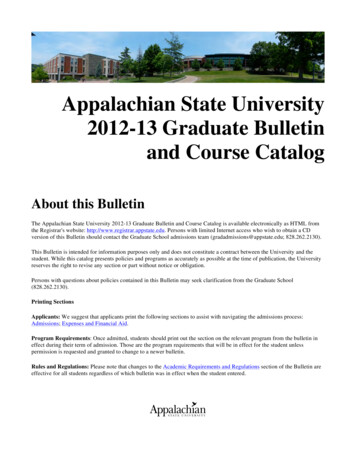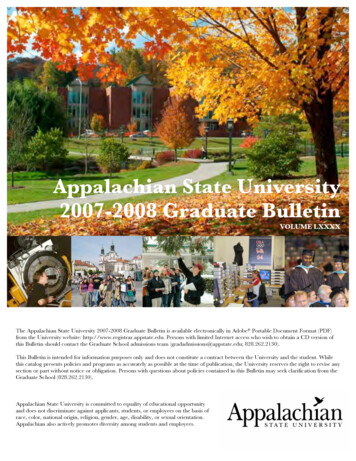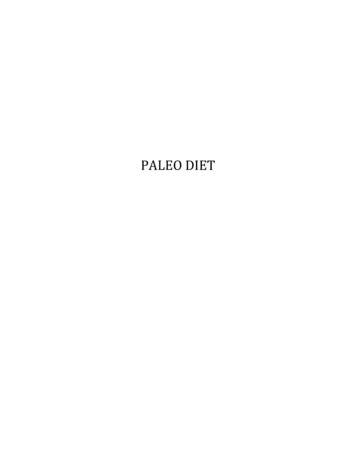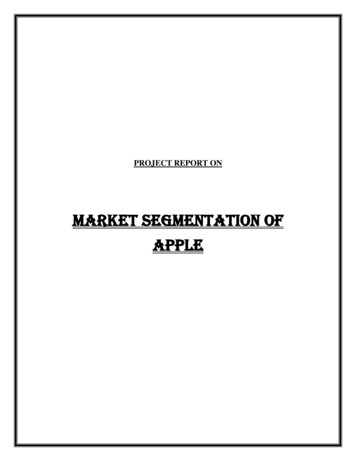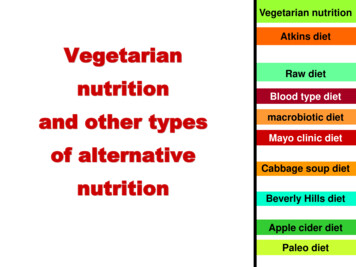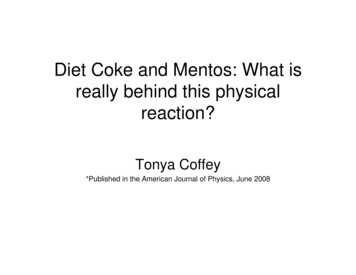
Transcription
Diet Coke and Mentos: What isreally behind this physicalreaction?Tonya Coffey*Published in the American Journal of Physics, June 2008
In case you hadn’t heard Diet Coke and Mentos is a majorfad!Subject of countless YouTube videos1st shown on the Lettermanshow in 1999 by chemistryteacher Lee MarekSubject of a 2006 episode of Mythbusters
Why on earth do I care so muchabout Mentos?Originally to give my PHY2210students the experience ofparticipating in a real researchproject, not a canned lab.But I admit the projectexploded beyond my originalvision
Bubble Theory: Why do sodas fizzwhen you open them?We like our drinks nice and fizzy.Thanks, Henry’s Law!P KcHere P is partial pressure of gas above liquid,K is a constant, and c is the molar concentration of solute.The partial pressure of the gas above the solution isdirectly proportional to the concentration of solute gas inthe solution.So when you pop the top, the equilibrium within the bottleor can is broken, and the concentrated carbon dioxide gasleaves the container. The partial pressure of carbondioxide in the surrounding gas then drops, forcing theconcentration of the solute gas to drop, so it bubbles out.
Bubble theory: How bubbles form inliquidsIn most liquids, there is some dissolved gas.In high surface tension liquids, like water, it istough for bubbles to form, because watermolecules like to be next to other watermolecules (capillary forces).To overcome this, a nucleation site isgenerally needed. Gas moleculescongregate next to nucleation sites, whichbreak up the network of water molecules.When enough are gathered, they form abubble.Due to capillary forces, the bubble will initiallystay at its nucleation site. But usually, thebuoyancy of the bubble will eventually causeit to rise, as more and more gas moleculescollect in the bubble.*Liger-Belair and Jeandet, Europhysics News
More fun bubble facts When a soda is bottled, it is bottled under arelatively high pressure of CO2 that exceeds thesolubility of CO2 in the rest of the formula (mostlywater). When the can is opened without shakinghigh pressure CO2 above the liquid escapes,making the familiar hiss. The CO2 in the liquidslowly escapes until equilibrium is achieved. Whenthe unopened can is shaken, some of the gaseousCO2 gets mixed into the liquid, forming asupersaturated solution. The mixed in gas alsoprovide growth sites for the dissolved CO2. Thegrowth sites allow the CO2 to escape much morerapidly-- hence the "explosive" evolution of CO2gas.
Bubble Theory: The importance ofsurfactants Adding surfactants towater reduce the workrequired to form abubble, making bubbleseasier to form andlonger lasting Surfactants are longchained molecules (likesoap) that have a waterloving and water fearingend
What burning questions did theMythbusters leave for me? Main Mentos contributors to the reaction: gum arabicand gelatin Main Diet Coke contributors to the reaction: caffeine,apsartame, potassium benzoate Rough surface of Mentos provides growth sites for thecarbon dioxide dissolved in Diet Coke How rough is Mentos compared to other samples andhow much does roughness matter compared topresence of surfactants in soda or candy? What is relative contribution of ingredients to reaction,and why do they work? Surfactants? Are there any other factors in play?
It’s not an acid/base reaction! Lots of speculation on theweb. We measured pH of sodabefore and after DietCoke/Mentos reaction usinga pH meter with a 2 pointcalibration. It was the same,3.0. Also, none of the ingredientsin Mentos are basic: sugar,glucose syrup, hydrogenatedcoconut oil, gelatin, dextrin,natural flavor, corn starch,The classic baking soda and vinegar acid-basereaction produces unstable carbonic acid that rapidlygum arabic.decomposes into water and carbon dioxide, whichescapes as a gas. For the Mentos–Diet Coke reaction, But you can make a funthe carbonic acid and carbon dioxide are not productsacid/base reaction, by addingof a chemical reaction but are already present in thebaking soda to Diet Coke.Diet Coke, whose equilibrium is disturbed by thepH before: 3.0 pH after: 6.1addition of the Mentos.
Procedure Sodas tested: Diet Coke,Caffeine Free Diet Coke,Coca-Cola Classic, CaffeineFree Coca-Cola Classic,seltzer water, seltzer waterwith potassium benzoateadded, seltzer water withaspartame added, tonicwater, and diet tonic water. Samples tested: MintMentos, Fruit Mentos, amixture of DawnDishwashing detergent andwater, playground sand,table salt, rock salt, Wint-ogreen Lifesavers, a mixtureof baking soda and water,liquid gum arabic, andmolecular sieve beads.
Procedure We constructed a bottle stand to prevent the bottles fromtipping over and to prevent the liquid from falling backinto the bottle. We also constructed a tube to fit overthe mouth of the bottle and a delivery mechanism for thesolid materials to maintain consistency in our results. We measured the mass of the bottle using a double panbalance before and after the reaction to determine themass lost in the reaction. We measured the horizontaldistance traveled by the soda’s spray using marker flagsand video. Also using video, we acquired time durationof reaction.
One of those other factors:Temperature! For temperature dependent trials werefrigerated a Diet Coke bottle forseveral hour prior to the experiment. Other bottles were heated in a waterbath on a hot plate for approximately 1020 minutes. To prevent explosion of thebottles during heating, the heated bottleswere opened to release some of theinternal pressure, then closed again. This may have caused some systematicerror as compared to the roomtemperature trials. Soda temperature was measured withmercury thermometer immediately priorto reaction.
Mass Lost (g)Temperature 6002040Temperature (Celsius)60Remember Henry’s Law?P KcThe Henry’s Law constantK changes withtemperature, generallyincreasing as thetemperature increases.This means that the molarconcentration of the gas inthe solution must drop forthe same value of thepartial pressure, whichmeans that gases are lesssoluble in liquids as thetemperature increases.
Which soda ingredients cause thebiggest reaction?
Results—Mass lost during reaction of Mentos inSeltzer, Tonic Water, Diet Tonic Water(Uncertainty roughly 10%)Seltzer WaterRanking3Tonic Water2Diet Tonic Water10100200300400500600Mass Lost (g)Artificial Sweeteners cause bigger explosions than sugar. None of thesedrinks contain caffeine.Seltzer ingredients: Carbonated waterTonic Water Ingredients: Carbonated water, corn syrup, citric acid, natural andartificial flavors, quinineDiet Tonic Water Ingredients: Carbonated water, citric acid, natural and artificialflavors, aspartame, potassium benzoate, quinine
Results—Mass lost during reaction of Mentos inVarious Coke Products (Uncertainty roughly 10%)Caffeine Free CokeRanking43Coke2Caffeine Free Diet Coke1Diet Coke12501300135014001450Mass Lost (g)Presence/absence of aspartame matters more thanpresence/absence of caffeine.
RankingResults—Horizontal distance traveled by sprayduring reaction of Mentos in Various CokeProducts (Uncertainty roughly 10%)4Coke3Caffeine Free Coke2Diet Coke1Caffeine Free Diet Coke051015Distance Traveled by Spray (ft)20 Presence/absence ofaspartame matters more thanpresence/absence of caffeine.
What about caffeine? Matters a little, but the differences arewithin the experimental error, so . The Mythbusters added “enough caffeineto kill you” and saw a reaction. Hopefullythe Coca-cola company doesn’t add thatmuch!
Why does aspartame/sugar mattermore than caffeine/caffeine free? To answer this question, we took contact anglemeasurements. What is contact angle? Whatdoes it tell us?θ316πγ LVW f (θ )(P' P )2(1 cos θ ) (2 cos θ )f (θ ) 4The work required to form a bubble in a liquid.Here, γLV is the liquid-vapor surface tension,P’-P is the pressure difference across theinterface, is the contact angle, and f is afunction of contact angle.
Contact Angle ResultsSampleContact angle indegrees (uncertainty of /- 3 degrees)Wso lnWH 20DI H20851DI H20-sugar solution800.74DI H20-aspartamesolution770.67DI H20-potassiumbenzoate solution750.60Diet Coke750.62Caffeine Free DietCoke780.693 γ LV , 2 f (θ 2 ) The smaller the γ f (θ ) ratio, the lessLV,11 work is requiredto form a bubble.Aspartamereduces the workmore than sugar.Potassiumbenzoate, thepreservative theyadd to beveragescontainingaspartame (likeDiet Coke) iseven better.Above, we assumed that the liquid-vapor surface tension was reduced by 5% for the second system ascompared to the de-ionized water (system 1).
So Caffeine, sugar, aspartame, and potassiumbenzoate all reduce the work required to form abubble However, the amount of caffeine in Diet Cokeisn’t large enough to significantly affect theexplosion Sugar doesn’t do as good of a job as aspartameand potassium benzoate They always add a preservative to drinkscontaining aspartame, so it makes an effective1-2 combo!
Sample Results10% UncertaintyHorizontal Distance Traveled by Spray (ft)2018Fruit Mentos16Mint Mentos1412Dawn1086Rock SaltLifesaversTable SaltSand4Cake MatesMolecular Sieve Pump Beads29001000110012001300Mass Lost during Reaction (g)14001500
Just about anything will make thefizz! Dropping any solid into soda will providenucleation sites for the bubbles. We injected some liquids that are knownsurfactants (Dawn/water mixture, liquid gumarabic) into the bottom of the soda pop bottles.That works too! So 2 important factors: nucleation sites andsurfactants which reduce work required to form abubble. Any other factors? And why do Mentos workbetter than anything else?
Rate of Reaction Matters!Horizontal Distance Traveled by Spray (ft)2018Fruit Mentos16Mint Mentos1412Dawn108Rock Salt6LifesaversTable SaltSand4Cake MatesMolecular Sieve Pump Beads2900100011001200130014001500Mass Lost during Reaction (g)Discrepancies exist between the amount of mass lost and distance traveled.Notable samples: Lifesavers, Molecular Sieve Pump Beads, Dawn. These can beexplained by the rate of reaction. Reactions that take longer to occur lose lots ofmass but the spray doesn’t travel very far. Think Mt. St. Helens vs. Kilauea.
Why are rates of reaction different?SampleFall TimeMentos0.7 sRock Salt andLifesaversTable Salt andSand1.0 s1.5 sSampleReactionDurationFruit Mentos3.4 sMint Mentos3.8 sLifesavers4.9 sMolecular Sieve 12 sBeadsThe porosity of the sample and the time to fall to the bottom of the bottle bothcontribute to the duration of the reaction. So for spray that goes a long way, you wanta sample that plummets to the bottom of the bottle, not one that drifts slowly down.
Roughness: SEM images of SamplesWe can get aqualitative feel for theroughness of sampleswith SEM, but not getquantitative.Unfortunately, wecouldn’t image all of oursamples in AFM due tosample height variationrestrictions.Large surface area tovolume ratio means moregrowth sites!Mint Mentos
AFM Roughness MeasurementsLeft: Mint Mentos. Z range: 3 microns. Right: Wintogreen Lifesavers. Z range: 18 microns
AFM rms roughnessmeasurementsSampleRoot mean square roughness (nm)Wint-o-green Lifesavers2630Fruit Mentos443Mint Mentos442Rock salt174These measurements are all from a 10 micron x 10 micron image of the sample.Roughness does matter, but it isn’t everything! The presence of surfactants inthe candy, like gum arabic in the Mentos outer coating, also makes the reactionmore explosive. You also have to factor in reaction duration, etc. This is acomplex system!!
What makes Diet Coke and Mentosso explosive? It’s not an acid/base reaction. Higher temperatures mean bigger explosions. The aspartame and potassium benzoate in the DietCoke do a better job than sugar. There’s not enough caffeine to matter much. A faster explosion is more impressive than a slower one. The quick reaction time, and rough surface combinedwith the surfactants in the candy coating on the Mentosmake it the most explosive. Fruit Mentos have a thickercandy coating but same roughness, so they’re better forbigger explosions than Mint Mentos.
Thanks!! This work was supported in part by thePetroleum Research Fund, grant numberPRF# 44936-GB5, an NC Space Grant,New Investigations award, and the ASUCollege of Arts and Sciences. We wouldlike to thank the Dewel Microscopy Facilityfor their donation of the time on the SEM.Guichuan Hou, Phil Russell, and DonovanLeonardPHY2210 students: Will Beuttell, JasonBurch, Blake Clark, Robert Duke, JamaGreene, AJ Hall, Jonathan Hearing,Leander Hutton, Kelly Izlar, Cully Little,James Lugenbell, Michael Mace, BonnieMyers, Carla Penders, Zach Russell,Shane Shields, Adrian Steffen, TonySturtzel, and Zach YokleySummer Research Assistants: AJ Hall,Magdalena Jaramillo, Cully Little, andZach Russell, and Jon JonesThanks for asking me to speak today.
baking soda to Diet Coke. pH before: 3.0 pH after: 6.1 The classic baking soda and vinegar acid-base reaction produces unstable carbonic acid that rapidly decomposes into water and carbon dioxide, which escapes as a gas. For the Mentos-Diet Coke reaction, the carbonic acid and carbon dioxide are not products

